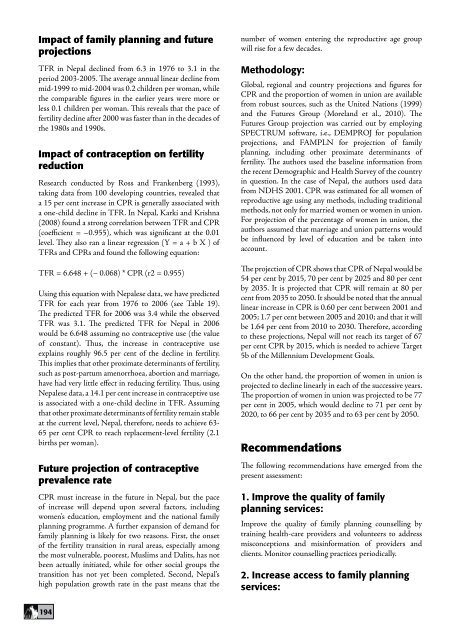Family Planning in Asia and the Pacific - International Council on ...
Family Planning in Asia and the Pacific - International Council on ...
Family Planning in Asia and the Pacific - International Council on ...
Create successful ePaper yourself
Turn your PDF publications into a flip-book with our unique Google optimized e-Paper software.
Impact of family plann<str<strong>on</strong>g>in</str<strong>on</strong>g>g <str<strong>on</strong>g>and</str<strong>on</strong>g> futureprojecti<strong>on</strong>sTFR <str<strong>on</strong>g>in</str<strong>on</strong>g> Nepal decl<str<strong>on</strong>g>in</str<strong>on</strong>g>ed from 6.3 <str<strong>on</strong>g>in</str<strong>on</strong>g> 1976 to 3.1 <str<strong>on</strong>g>in</str<strong>on</strong>g> <str<strong>on</strong>g>the</str<strong>on</strong>g>period 2003-2005. The average annual l<str<strong>on</strong>g>in</str<strong>on</strong>g>ear decl<str<strong>on</strong>g>in</str<strong>on</strong>g>e frommid-1999 to mid-2004 was 0.2 children per woman, while<str<strong>on</strong>g>the</str<strong>on</strong>g> comparable figures <str<strong>on</strong>g>in</str<strong>on</strong>g> <str<strong>on</strong>g>the</str<strong>on</strong>g> earlier years were more orless 0.1 children per woman. This reveals that <str<strong>on</strong>g>the</str<strong>on</strong>g> pace offertility decl<str<strong>on</strong>g>in</str<strong>on</strong>g>e after 2000 was faster than <str<strong>on</strong>g>in</str<strong>on</strong>g> <str<strong>on</strong>g>the</str<strong>on</strong>g> decades of<str<strong>on</strong>g>the</str<strong>on</strong>g> 1980s <str<strong>on</strong>g>and</str<strong>on</strong>g> 1990s.Impact of c<strong>on</strong>tracepti<strong>on</strong> <strong>on</strong> fertilityreducti<strong>on</strong>Research c<strong>on</strong>ducted by Ross <str<strong>on</strong>g>and</str<strong>on</strong>g> Frankenberg (1993),tak<str<strong>on</strong>g>in</str<strong>on</strong>g>g data from 100 develop<str<strong>on</strong>g>in</str<strong>on</strong>g>g countries, revealed thata 15 per cent <str<strong>on</strong>g>in</str<strong>on</strong>g>crease <str<strong>on</strong>g>in</str<strong>on</strong>g> CPR is generally associated witha <strong>on</strong>e-child decl<str<strong>on</strong>g>in</str<strong>on</strong>g>e <str<strong>on</strong>g>in</str<strong>on</strong>g> TFR. In Nepal, Karki <str<strong>on</strong>g>and</str<strong>on</strong>g> Krishna(2008) found a str<strong>on</strong>g correlati<strong>on</strong> between TFR <str<strong>on</strong>g>and</str<strong>on</strong>g> CPR(coefficient = –0.955), which was significant at <str<strong>on</strong>g>the</str<strong>on</strong>g> 0.01level. They also ran a l<str<strong>on</strong>g>in</str<strong>on</strong>g>ear regressi<strong>on</strong> (Y = a + b X ) ofTFRs <str<strong>on</strong>g>and</str<strong>on</strong>g> CPRs <str<strong>on</strong>g>and</str<strong>on</strong>g> found <str<strong>on</strong>g>the</str<strong>on</strong>g> follow<str<strong>on</strong>g>in</str<strong>on</strong>g>g equati<strong>on</strong>:TFR = 6.648 + (– 0.068) * CPR (r2 = 0.955)Us<str<strong>on</strong>g>in</str<strong>on</strong>g>g this equati<strong>on</strong> with Nepalese data, we have predictedTFR for each year from 1976 to 2006 (see Table 19).The predicted TFR for 2006 was 3.4 while <str<strong>on</strong>g>the</str<strong>on</strong>g> observedTFR was 3.1. The predicted TFR for Nepal <str<strong>on</strong>g>in</str<strong>on</strong>g> 2006would be 6.648 assum<str<strong>on</strong>g>in</str<strong>on</strong>g>g no c<strong>on</strong>traceptive use (<str<strong>on</strong>g>the</str<strong>on</strong>g> valueof c<strong>on</strong>stant). Thus, <str<strong>on</strong>g>the</str<strong>on</strong>g> <str<strong>on</strong>g>in</str<strong>on</strong>g>crease <str<strong>on</strong>g>in</str<strong>on</strong>g> c<strong>on</strong>traceptive useexpla<str<strong>on</strong>g>in</str<strong>on</strong>g>s roughly 96.5 per cent of <str<strong>on</strong>g>the</str<strong>on</strong>g> decl<str<strong>on</strong>g>in</str<strong>on</strong>g>e <str<strong>on</strong>g>in</str<strong>on</strong>g> fertility.This implies that o<str<strong>on</strong>g>the</str<strong>on</strong>g>r proximate determ<str<strong>on</strong>g>in</str<strong>on</strong>g>ants of fertility,such as post-partum amenorrhoea, aborti<strong>on</strong> <str<strong>on</strong>g>and</str<strong>on</strong>g> marriage,have had very little effect <str<strong>on</strong>g>in</str<strong>on</strong>g> reduc<str<strong>on</strong>g>in</str<strong>on</strong>g>g fertility. Thus, us<str<strong>on</strong>g>in</str<strong>on</strong>g>gNepalese data, a 14.1 per cent <str<strong>on</strong>g>in</str<strong>on</strong>g>crease <str<strong>on</strong>g>in</str<strong>on</strong>g> c<strong>on</strong>traceptive useis associated with a <strong>on</strong>e-child decl<str<strong>on</strong>g>in</str<strong>on</strong>g>e <str<strong>on</strong>g>in</str<strong>on</strong>g> TFR. Assum<str<strong>on</strong>g>in</str<strong>on</strong>g>gthat o<str<strong>on</strong>g>the</str<strong>on</strong>g>r proximate determ<str<strong>on</strong>g>in</str<strong>on</strong>g>ants of fertility rema<str<strong>on</strong>g>in</str<strong>on</strong>g> stableat <str<strong>on</strong>g>the</str<strong>on</strong>g> current level, Nepal, <str<strong>on</strong>g>the</str<strong>on</strong>g>refore, needs to achieve 63-65 per cent CPR to reach replacement-level fertility (2.1births per woman).Future projecti<strong>on</strong> of c<strong>on</strong>traceptiveprevalence rateCPR must <str<strong>on</strong>g>in</str<strong>on</strong>g>crease <str<strong>on</strong>g>in</str<strong>on</strong>g> <str<strong>on</strong>g>the</str<strong>on</strong>g> future <str<strong>on</strong>g>in</str<strong>on</strong>g> Nepal, but <str<strong>on</strong>g>the</str<strong>on</strong>g> paceof <str<strong>on</strong>g>in</str<strong>on</strong>g>crease will depend up<strong>on</strong> several factors, <str<strong>on</strong>g>in</str<strong>on</strong>g>clud<str<strong>on</strong>g>in</str<strong>on</strong>g>gwomen’s educati<strong>on</strong>, employment <str<strong>on</strong>g>and</str<strong>on</strong>g> <str<strong>on</strong>g>the</str<strong>on</strong>g> nati<strong>on</strong>al familyplann<str<strong>on</strong>g>in</str<strong>on</strong>g>g programme. A fur<str<strong>on</strong>g>the</str<strong>on</strong>g>r expansi<strong>on</strong> of dem<str<strong>on</strong>g>and</str<strong>on</strong>g> forfamily plann<str<strong>on</strong>g>in</str<strong>on</strong>g>g is likely for two reas<strong>on</strong>s. First, <str<strong>on</strong>g>the</str<strong>on</strong>g> <strong>on</strong>setof <str<strong>on</strong>g>the</str<strong>on</strong>g> fertility transiti<strong>on</strong> <str<strong>on</strong>g>in</str<strong>on</strong>g> rural areas, especially am<strong>on</strong>g<str<strong>on</strong>g>the</str<strong>on</strong>g> most vulnerable, poorest, Muslims <str<strong>on</strong>g>and</str<strong>on</strong>g> Dalits, has notbeen actually <str<strong>on</strong>g>in</str<strong>on</strong>g>itiated, while for o<str<strong>on</strong>g>the</str<strong>on</strong>g>r social groups <str<strong>on</strong>g>the</str<strong>on</strong>g>transiti<strong>on</strong> has not yet been completed. Sec<strong>on</strong>d, Nepal’shigh populati<strong>on</strong> growth rate <str<strong>on</strong>g>in</str<strong>on</strong>g> <str<strong>on</strong>g>the</str<strong>on</strong>g> past means that <str<strong>on</strong>g>the</str<strong>on</strong>g>number of women enter<str<strong>on</strong>g>in</str<strong>on</strong>g>g <str<strong>on</strong>g>the</str<strong>on</strong>g> reproductive age groupwill rise for a few decades.Methodology:Global, regi<strong>on</strong>al <str<strong>on</strong>g>and</str<strong>on</strong>g> country projecti<strong>on</strong>s <str<strong>on</strong>g>and</str<strong>on</strong>g> figures forCPR <str<strong>on</strong>g>and</str<strong>on</strong>g> <str<strong>on</strong>g>the</str<strong>on</strong>g> proporti<strong>on</strong> of women <str<strong>on</strong>g>in</str<strong>on</strong>g> uni<strong>on</strong> are availablefrom robust sources, such as <str<strong>on</strong>g>the</str<strong>on</strong>g> United Nati<strong>on</strong>s (1999)<str<strong>on</strong>g>and</str<strong>on</strong>g> <str<strong>on</strong>g>the</str<strong>on</strong>g> Futures Group (Morel<str<strong>on</strong>g>and</str<strong>on</strong>g> et al., 2010). TheFutures Group projecti<strong>on</strong> was carried out by employ<str<strong>on</strong>g>in</str<strong>on</strong>g>gSPECTRUM software, i.e., DEMPROJ for populati<strong>on</strong>projecti<strong>on</strong>s, <str<strong>on</strong>g>and</str<strong>on</strong>g> FAMPLN for projecti<strong>on</strong> of familyplann<str<strong>on</strong>g>in</str<strong>on</strong>g>g, <str<strong>on</strong>g>in</str<strong>on</strong>g>clud<str<strong>on</strong>g>in</str<strong>on</strong>g>g o<str<strong>on</strong>g>the</str<strong>on</strong>g>r proximate determ<str<strong>on</strong>g>in</str<strong>on</strong>g>ants offertility. The authors used <str<strong>on</strong>g>the</str<strong>on</strong>g> basel<str<strong>on</strong>g>in</str<strong>on</strong>g>e <str<strong>on</strong>g>in</str<strong>on</strong>g>formati<strong>on</strong> from<str<strong>on</strong>g>the</str<strong>on</strong>g> recent Demographic <str<strong>on</strong>g>and</str<strong>on</strong>g> Health Survey of <str<strong>on</strong>g>the</str<strong>on</strong>g> country<str<strong>on</strong>g>in</str<strong>on</strong>g> questi<strong>on</strong>. In <str<strong>on</strong>g>the</str<strong>on</strong>g> case of Nepal, <str<strong>on</strong>g>the</str<strong>on</strong>g> authors used datafrom NDHS 2001. CPR was estimated for all women ofreproductive age us<str<strong>on</strong>g>in</str<strong>on</strong>g>g any methods, <str<strong>on</strong>g>in</str<strong>on</strong>g>clud<str<strong>on</strong>g>in</str<strong>on</strong>g>g traditi<strong>on</strong>almethods, not <strong>on</strong>ly for married women or women <str<strong>on</strong>g>in</str<strong>on</strong>g> uni<strong>on</strong>.For projecti<strong>on</strong> of <str<strong>on</strong>g>the</str<strong>on</strong>g> percentage of women <str<strong>on</strong>g>in</str<strong>on</strong>g> uni<strong>on</strong>, <str<strong>on</strong>g>the</str<strong>on</strong>g>authors assumed that marriage <str<strong>on</strong>g>and</str<strong>on</strong>g> uni<strong>on</strong> patterns wouldbe <str<strong>on</strong>g>in</str<strong>on</strong>g>fluenced by level of educati<strong>on</strong> <str<strong>on</strong>g>and</str<strong>on</strong>g> be taken <str<strong>on</strong>g>in</str<strong>on</strong>g>toaccount.The projecti<strong>on</strong> of CPR shows that CPR of Nepal would be54 per cent by 2015, 70 per cent by 2025 <str<strong>on</strong>g>and</str<strong>on</strong>g> 80 per centby 2035. It is projected that CPR will rema<str<strong>on</strong>g>in</str<strong>on</strong>g> at 80 percent from 2035 to 2050. It should be noted that <str<strong>on</strong>g>the</str<strong>on</strong>g> annuall<str<strong>on</strong>g>in</str<strong>on</strong>g>ear <str<strong>on</strong>g>in</str<strong>on</strong>g>crease <str<strong>on</strong>g>in</str<strong>on</strong>g> CPR is 0.60 per cent between 2001 <str<strong>on</strong>g>and</str<strong>on</strong>g>2005; 1.7 per cent between 2005 <str<strong>on</strong>g>and</str<strong>on</strong>g> 2010; <str<strong>on</strong>g>and</str<strong>on</strong>g> that it willbe 1.64 per cent from 2010 to 2030. Therefore, accord<str<strong>on</strong>g>in</str<strong>on</strong>g>gto <str<strong>on</strong>g>the</str<strong>on</strong>g>se projecti<strong>on</strong>s, Nepal will not reach its target of 67per cent CPR by 2015, which is needed to achieve Target5b of <str<strong>on</strong>g>the</str<strong>on</strong>g> Millennium Development Goals.On <str<strong>on</strong>g>the</str<strong>on</strong>g> o<str<strong>on</strong>g>the</str<strong>on</strong>g>r h<str<strong>on</strong>g>and</str<strong>on</strong>g>, <str<strong>on</strong>g>the</str<strong>on</strong>g> proporti<strong>on</strong> of women <str<strong>on</strong>g>in</str<strong>on</strong>g> uni<strong>on</strong> isprojected to decl<str<strong>on</strong>g>in</str<strong>on</strong>g>e l<str<strong>on</strong>g>in</str<strong>on</strong>g>early <str<strong>on</strong>g>in</str<strong>on</strong>g> each of <str<strong>on</strong>g>the</str<strong>on</strong>g> successive years.The proporti<strong>on</strong> of women <str<strong>on</strong>g>in</str<strong>on</strong>g> uni<strong>on</strong> was projected to be 77per cent <str<strong>on</strong>g>in</str<strong>on</strong>g> 2005, which would decl<str<strong>on</strong>g>in</str<strong>on</strong>g>e to 71 per cent by2020, to 66 per cent by 2035 <str<strong>on</strong>g>and</str<strong>on</strong>g> to 63 per cent by 2050.Recommendati<strong>on</strong>sThe follow<str<strong>on</strong>g>in</str<strong>on</strong>g>g recommendati<strong>on</strong>s have emerged from <str<strong>on</strong>g>the</str<strong>on</strong>g>present assessment:1. Improve <str<strong>on</strong>g>the</str<strong>on</strong>g> quality of familyplann<str<strong>on</strong>g>in</str<strong>on</strong>g>g services:Improve <str<strong>on</strong>g>the</str<strong>on</strong>g> quality of family plann<str<strong>on</strong>g>in</str<strong>on</strong>g>g counsell<str<strong>on</strong>g>in</str<strong>on</strong>g>g bytra<str<strong>on</strong>g>in</str<strong>on</strong>g><str<strong>on</strong>g>in</str<strong>on</strong>g>g health-care providers <str<strong>on</strong>g>and</str<strong>on</strong>g> volunteers to addressmisc<strong>on</strong>cepti<strong>on</strong>s <str<strong>on</strong>g>and</str<strong>on</strong>g> mis<str<strong>on</strong>g>in</str<strong>on</strong>g>formati<strong>on</strong> of providers <str<strong>on</strong>g>and</str<strong>on</strong>g>clients. M<strong>on</strong>itor counsell<str<strong>on</strong>g>in</str<strong>on</strong>g>g practices periodically.2. Increase access to family plann<str<strong>on</strong>g>in</str<strong>on</strong>g>gservices:194














